Introduction
The Agile Discovery Process is a dynamic and flexible approach to problem-solving that has revolutionized project management in today's rapidly evolving digital landscape. This methodology emphasizes adaptability and iterative progress through collaboration and cross-functional teamwork. By embracing change and continuously refining solutions based on customer feedback and market trends, Agile enables teams to pivot swiftly and deliver more responsive and effective outcomes.
In this article, we will explore the benefits of Agile Discovery, step-by-step guide to implementing it, and the tools and techniques that support its success. We will also discuss common challenges and best practices for implementing Agile Discovery in software development. So, let's dive into the world of Agile and discover its transformative impact on project management.
What is Agile Discovery Process?
The Agile Discovery Process embodies a dynamic approach to problem-solving, emphasizing flexibility and iterative progress through collaborative efforts of cross-functional teams. At its core, Agile is about embracing change and adapting to new insights, which is crucial in today's rapidly evolving digital landscape. The methodology has revolutionized project management by allowing teams to pivot swiftly in response to customer feedback, market trends, and the project's emerging needs.
Drawing from real-world applications, a noteworthy case comes from a large retailer in Northwest Arkansas. Here, the logistics team dealt with an outdated legacy system composed of various older systems merged over two decades. To break away from the 'feature factory' mindset and functional silos, they adopted Dual Track Agile, which separates work into two streams: the 'Delivery' track, focusing on developing and shipping features, and the 'Discovery' track, which involves research, experimentation, and maintenance tasks.
Another example is Bosch's innovation of the solid oxide fuel cell (SOFC) system. This high-efficiency, low-emission source of electrical power is enhanced by a digital twin that visualizes and monitors process parameters, optimizing cost and performance over the system's lifetime. Agile principles play a vital role in managing such complex projects, where adaptability and customer-centricity are paramount.
Agile's principles, first outlined in the Manifesto for Agile Software Development in 2001, argue that welcoming changes even late in the project can lead to more successful outcomes. This contrasts sharply with the waterfall approach, which often results in rigid and inflexible project paths. Agile's emphasis on rapid iterations and the acceptance of potential failures as a pathway to progress is a testament to its transformative impact on project management.
The essence of Agile, as highlighted by a Full-Stack Developer, Laís Ortiz, is not merely about speed but about moving through processes in a flexible manner that yields faster and more satisfactory results. This approach is encapsulated in the 'develop loop,' which is often misinterpreted. Rather than a single iteration, Agile involves multiple iterations, where business and development teams continuously collaborate to refine and deliver features, ultimately leading to a more responsive and effective product development cycle.
Benefits of Agile Discovery Process
Incorporating the Agile Discovery Process into project management has been a game-changer for many organizations. It is not just a theoretical approach but a practical, evidenced-based strategy that has proven its worth across diverse industries. For instance, a large retailer in Northwest Arkansas significantly improved their logistics operations by adopting a Dual Track Agile methodology.
This approach divided tasks into a 'Delivery' stream for well-defined user stories ready for development and a 'Discovery' stream for tasks that needed research and experimentation, like proof of concepts and architectural designs. Such a structure allowed for a more efficient and flexible process, aligning with the core Agile principles of adaptability and customer-centric development.
Another testament to the Agile Discovery Process's success is Bosch's engineering triumph with the solid oxide fuel cell (SOFC) system. Their ability to use a digital twin to optimize the system's cost and performance over its lifetime is a brilliant example of Agile's emphasis on continuous improvement and learning. This is Agile in action—promoting a culture that values experimentation, which can lead to innovative solutions.
Statistics further underscore the impact of Agile methodologies. Gallup's research on agility, the Agile, identified key drivers that allow quick responses to changing business needs. Their findings revealed that employees who perceive their company as agile are more likely to believe in their competitive edge and financial security.
However, the research also highlighted a stark reality: while 94% of companies had initiated Agile transformations, only 53% truly embraced Agile principles to achieve improved performance, such as a 15% to 20% reduction in delivery costs and twice as fast product delivery.
In conclusion, the Agile Discovery Process goes beyond immediate benefits, such as early feedback and interdisciplinary collaboration. It creates an environment where continuous learning and innovation are not just encouraged but embedded in the very fabric of the organization's operations.
Step-by-Step Guide to Agile Discovery Process
The Agile Discovery Process is a strategic approach to software development that encourages iterative progress through collaboration and flexibility. At its core, Agile Discovery involves a series of steps designed to navigate from problem identification to solution validation. This dynamic begins with a strong emphasis on understanding the problem at hand.
Teams must engage in thorough research, drawing on techniques such as competitive analysis to understand industry standards and market gaps that present opportunities for innovation.
Following this, analyzing quantitative data illuminates patterns and trends, guiding the development of targeted solutions that are aligned with market needs. It is also the stage where managing stakeholder expectations becomes crucial, as their buy-in is essential for smooth progression. Effective communication and clear definitions of roles and responsibilities are pivotal to this process.
Solution development is enhanced by structuring work into user stories that articulate the needs and desires of the end user, ensuring that product features are developed with a clear understanding of the intended outcome. This user-centric approach is fundamental to Agile, as it advocates for rapid iterations that welcome changes at any stage to create the most value for users.
Validation is the final step, where solutions are tested and refined to meet the highest standards. The inclusion of several iterations within this phase is critical, contrary to the misconception that there should only be one cycle. Multiple iterations allow for continuous improvement and adaptation, which is at the heart of Agile philosophy.
An example of this process in action can be seen in a large Northwest Arkansas retailer's journey to overcome challenges in their logistics operations. By adopting a Dual Track Agile methodology, they were able to separate the delivery of ready-to-develop user stories from the discovery of those requiring more research and experimentation. This approach allowed for a continuous flow of tasks, with a Kanban style for discovery and Scrum for delivery, ensuring efficiency and adaptability.
Furthermore, Bosch's development of the solid oxide fuel cell (SOFC) system exemplifies Agile Discovery in a real-world context. The SOFC, a high-efficiency, low-emission energy converter, is backed by a digital twin that enables optimization over its lifecycle, illustrating the blend of physical and digital engineering prowess with a focus on sustainability.
Despite its benefits, Agile faces challenges in adapting to changing work environments and evolving technologies, such as AI. While Agile's principles are widely appreciated, especially in smaller firms, it is encountering resistance in larger organizations where the transition from traditional 'waterfall' methods to Agile's flexible framework presents a cultural shift. Yet, the commitment to 'working software as the primary measure of progress' remains a guiding light for Agile practitioners.
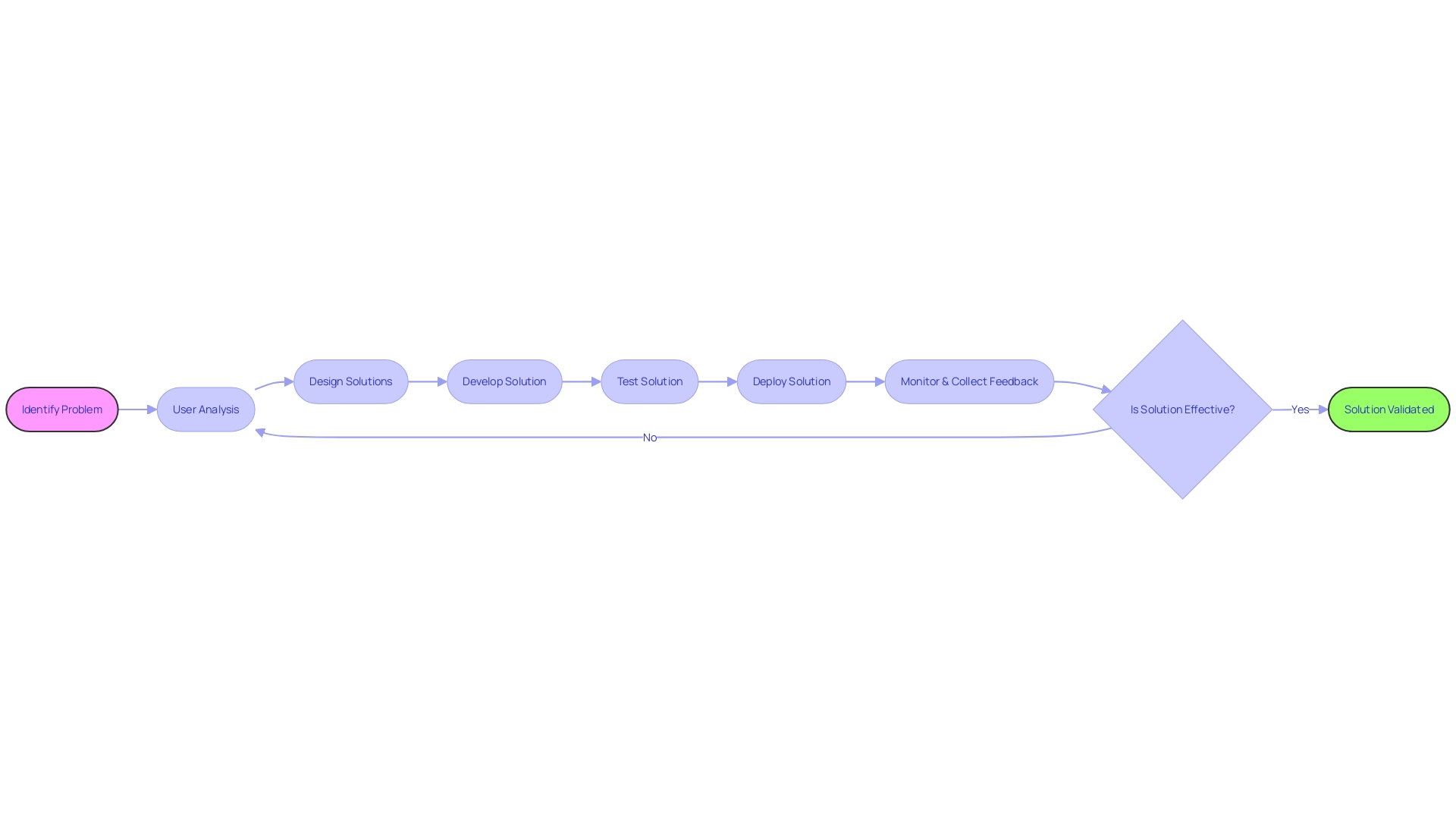
Step 1: Define the Problem
Defining the problem in any project is a critical step, where the focus is honed in on the specific challenges to overcome. It's a process that requires deep insight into the needs and frustrations of the end-users, aiming to pinpoint the outcomes that would represent success. The essence of this phase is to translate the abstract pain points into concrete goals that guide the project's trajectory.
Drawing from the insights of Donald Reinertsen and his work on product development flow, the importance of aligning the problem with the economic impact cannot be overstated. For instance, in the scenario of a mobile app designed for booking parking spaces, identifying the core issues is fundamental to directing limited resources effectively.
In practice, a well-crafted problem statement, devoid of bias and rooted in provable facts, becomes the compass for the project. It should detail the problem, explain its significance, and list the key stakeholders involved. By addressing the five W's—who, what, where, when, and why—clarity is brought to the forefront, ensuring that all team members understand the issue at hand and can contribute informed solutions.
This structure, as outlined in recent discussions on problem statements, is crucial for maintaining focus and fostering a collaborative environment.
A problem statement should be more than a declaration; it's a strategic tool that bridges the communication gap between customers and developers, as highlighted in scenarios where technical jargon obscures the real user needs. It's about understanding why users cling to their spreadsheets, the intricacies of their processes, and how they measure success. Just as Bernbach turned Volkswagen's problem into an opportunity, so too must modern teams convert challenges into stepping stones for innovation, utilizing insights from all relevant sources, including industry reports and analogous projects.
Ultimately, defining the problem with precision and clear economic measures sets the stage for the successful realization of project goals.
Step 2: Conduct User Research
Gaining a deep understanding of user needs and behaviors is an essential component of the Agile Discovery Process. By employing a variety of research techniques such as interviews, survey questionnaires, and direct observations, we delve into the intricacies of users' interactions with products and services. This isn't just about noting down what users do; it's about grasping their motivations, pinpointing their frustrations, and identifying opportunities for innovation.
The essence of user research is to illuminate the path for solution development, ensuring that the end result resonates with users and addresses their core needs effectively.
Documenting use cases is a prime example of how this understanding translates into actionable insights. By clearly defining the roles of Actors and UseCases, we delineate the boundaries of what the system is intended to achieve. This methodical approach not only captures the goals of the primary actor but also outlines the main scenario for achieving those goals.
It's crucial to recognize potential alternative paths and roadblocks, ensuring a comprehensive strategy for solution development.
Recent industry surveys have highlighted a growing demand for user research, with 62% of respondents acknowledging an uptick in the past year. This trend underscores the importance of research in mitigating risks and refining business strategies, particularly in today's competitive and uncertain market landscape. As the industry continues to evolve, leveraging user research throughout the product development lifecycle has become a pivotal practice for those aiming to 'get it right' the first time around.
Diary studies exemplify a longitudinal approach to user research, capturing a sequence of user interactions over time to provide a nuanced view of behavioral patterns. This method complements the more instantaneous snapshots provided by other research techniques, offering a richer, temporal perspective on user experiences.
As we navigate the complexities of the Agile Discovery Process, it is essential to remember that research is not a one-size-fits-all endeavor. Each project presents unique challenges and requires a tailored approach to uncovering the insights that will drive successful solution development.
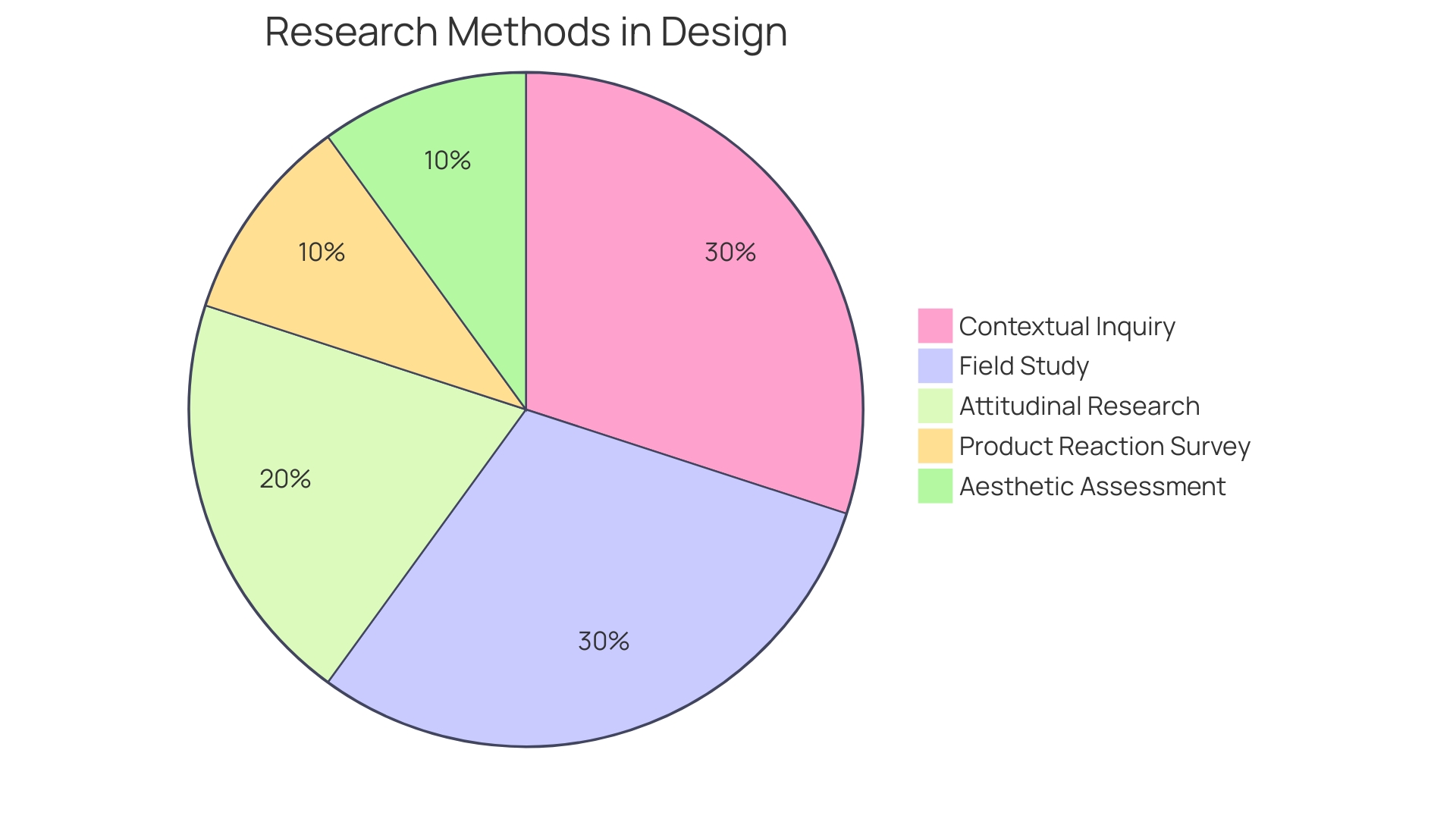
Step 3: Analyze Data and Identify Patterns
Analyzing user research data is not just about spotting patterns; it’s about unlocking actionable insights that drive strategic decisions. Wayfair, for instance, uses machine learning to parse millions of product attributes, ensuring customers find exactly what they’re looking for – like that 'modern yellow sofa.' Similarly, Reddit’s missteps in mobile experience highlight the importance of aligning design principles with user expectations to foster engagement.
In the rapidly evolving e-commerce landscape, understanding market shifts and customer behavior is critical. Asset management firms like Columbia Threadneedle leverage predictive tools to unearth investment opportunities, while frontline workers benefit from data analytics for enhanced decision-making. Indeed, organizations that harness customer insights can significantly outperform their competitors in sales growth and margins.
The demand for user research is surging, as evidenced by a survey pointing to a 62% rise over the past year. This uptick is propelled by the need for risk mitigation and clear business strategies in uncertain times. The key is not only to collect user data but to distill it into meaningful experiences that resonate with users and address their core needs.
This strategic approach to UX research asks the fundamental question: 'Are we solving the right problems?' By focusing on the user experience rather than the product, companies can unlock new avenues for innovation and value creation.
Ultimately, data analysis is a multifaceted process that begins with a clear objective and encompasses data collection, cleaning, and interpretation. It’s a critical component for informed decision-making, and it empowers businesses to adapt and thrive in a data-driven world.
Step 4: Develop Hypotheses and Solutions
Gathering insights from user research and data analysis is a pivotal step in developing effective hypotheses and potential solutions. This stage is about creative problem-solving and identifying the most viable options. By looking at successful examples like Airbnb, which distinguished itself in the short-term rental market by providing income opportunities for a wide range of property owners, we can understand the importance of defining the customer and the problem.
Unlike traditional pitch decks and financial models, which are based on assumptions and projections, this process is grounded in concrete data and real-world challenges. It requires a deep dive into the problem at hand, an understanding of why it matters, and a recognition of the stakeholders involved. With these elements in place, teams can confidently move forward, knowing their proposed solutions are more than just theories—they're informed responses to genuine market needs.
As we see with innovations like alternative fuel flights and initiatives against period poverty, this approach is not only theoretical but also practically applicable, leading to groundbreaking advancements and positive social impact.
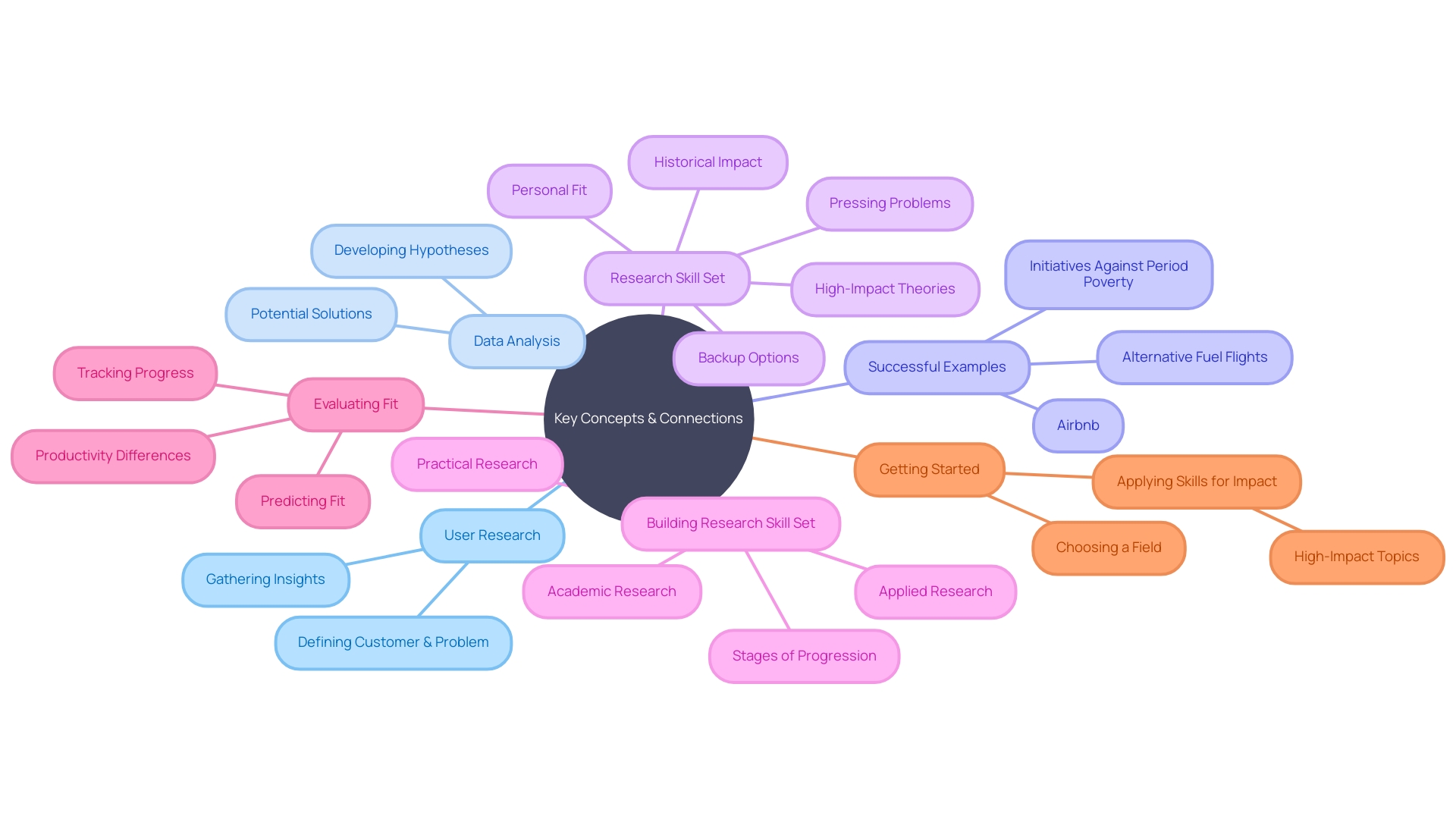
Step 5: Validate Solutions through Prototyping
The Agile Discovery Process embraces an evolutionary approach to development, emphasizing the importance of test-driven development where writing an automated test precedes creating functional code. This cycle of development not only ensures a coherent cross-functional design but also guarantees the creation of clean code that works consistently. Within this framework, prototyping emerges as a pivotal technique.
Prototyping in Agile involves developing low-fidelity models, known as throwaway prototypes, which serve as a tool for knowledge acquisition rather than final products. These prototypes are crafted to validate the feasibility of the core concepts and ideas behind a product, offering a preliminary demonstration to ascertain if the proposed solution effectively addresses the problem at hand.
For instance, the multinational corporation ICL, which operates in harsh mining conditions, relies on prototyping to monitor industrial equipment. By testing prototypes in extreme environments, they ensure that the final monitoring solutions are both feasible and durable, despite low and high temperatures, vibrations, saltwater, and dust.
Moreover, the Agile methodology, established in 2001, champions rapid iterations and embraces changes even at late project stages, with the Manifesto for Agile Software Development underscoring 'working software as the primary measure of progress.' This iterative feedback loop facilitated by prototyping allows teams to refine their solutions continually and align them more closely with user needs.
The process of prototyping is not just about creating an artifact; it's a strategic phase that allows for the exploration and creation of a solution. It aligns with the Double Diamond design process, which encourages divergence in thinking to explore numerous options before converging on a single, well-defined solution, thereby encapsulating the essence of 'design the right thing' and 'design the thing right.'
In the modern tech landscape, where developer burnout and shifting work environments pose significant challenges, the resilient philosophy of Agile and the practice of prototyping remain more relevant than ever, facilitating discovery, experimentation, and planning that lead to innovation and ultimately, successful product delivery.
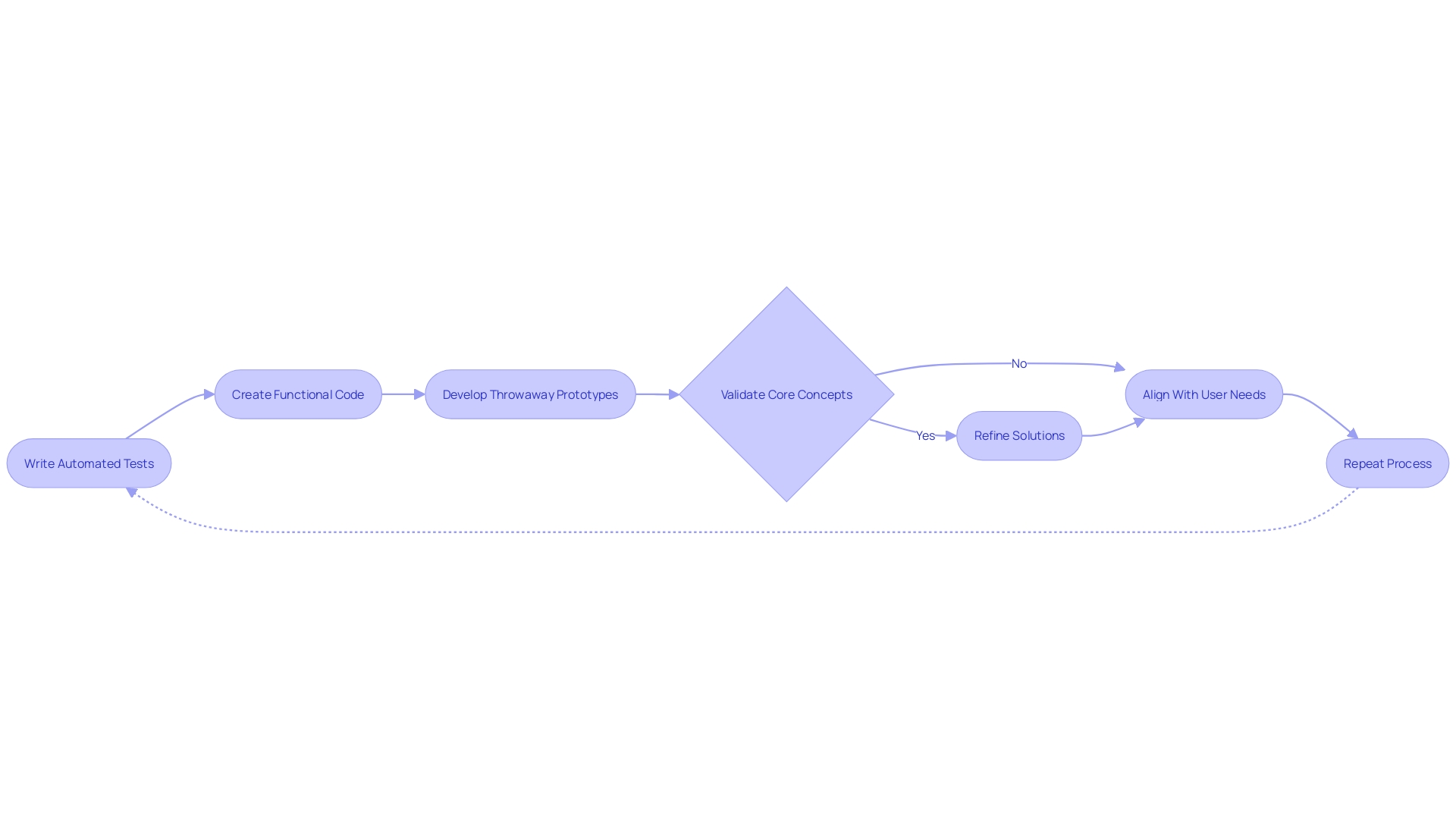
Step 6: Iterate and Refine Solutions
As the development team navigates the aftermath of the prototyping phase, their focus sharpens on refining the proposed solutions. It's a process that is likened to chiseling a sculpture from raw stone, where each iteration is guided by user feedback and aims to enhance the user experience. Alistair Cockburn, in his seminal book 'Writing Effective Use Cases,' emphasized the importance of user requirements, which are garnered through use cases.
These serve as a developmental lighthouse, steering the course of the solution towards the intended outcomes. This iterative approach is critical because, as we know, the vast majority of new tech products do not succeed. Often, features are underused or ignored entirely, highlighting the importance of validating each step with actual user engagement.
Moreover, this methodology aligns with the overarching strategy of focusing on vision and target outcomes. It is about discerning between 'good' and 'great' ideas, knowing that the best solutions are rarely the first ones conceived. By investing time in problem definition and ideation, and then rigorously analyzing, designing, and testing ideas, businesses can avoid the pitfall of rushing to solutions without understanding the complexities of the issue at hand.
The long-term success of a company hinges on creating value for its customers—developing something that not only meets but exceeds their expectations and is preferred over the competition. Therefore, the cycle of iteration is not just a phase but a cornerstone of creating a product that embodies this value.
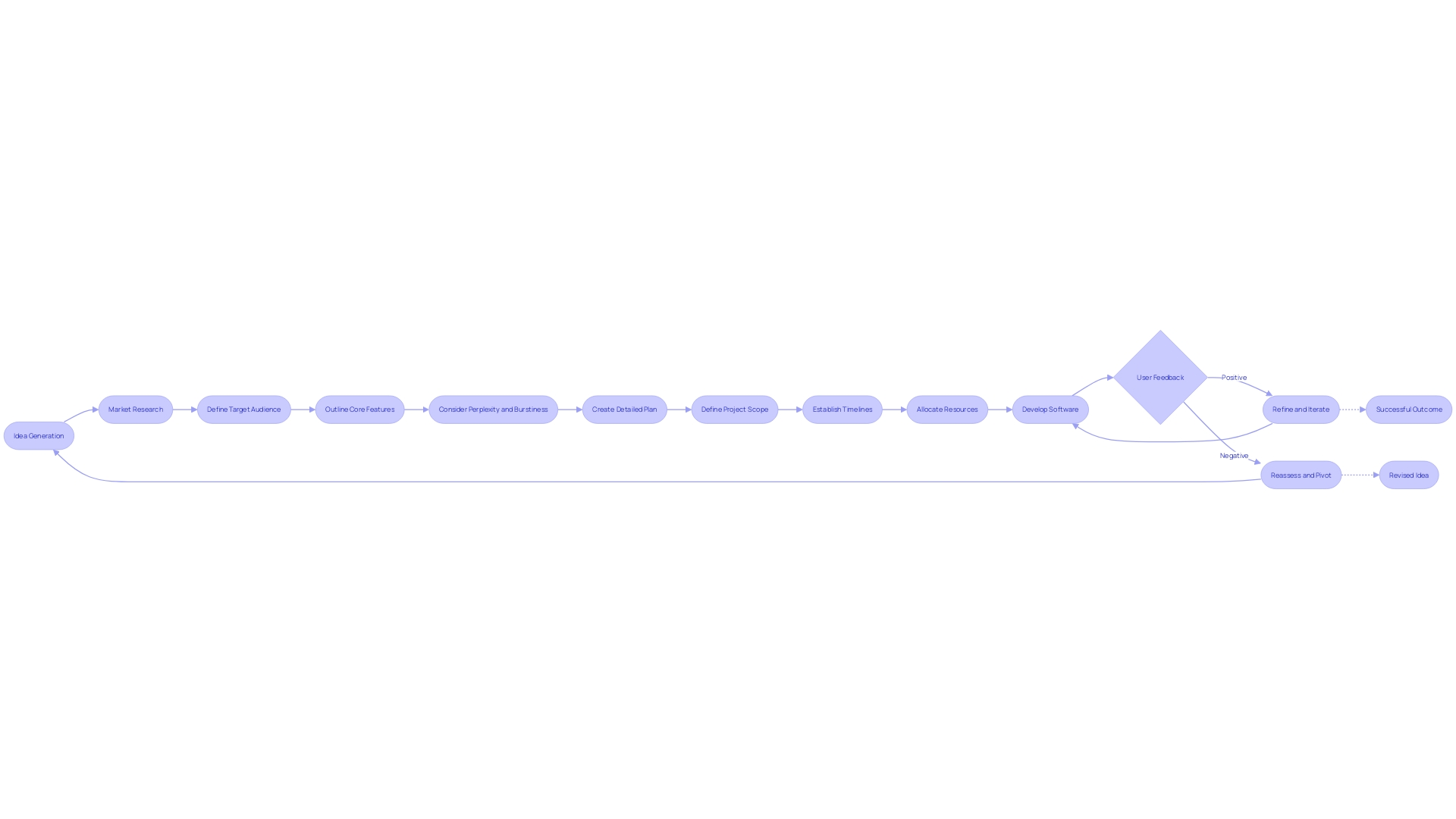
Tools and Techniques for Agile Discovery
Enhancing the understanding of user needs within an Agile framework is pivotal for creating software that not only functions well but also delivers an exceptional user experience. This endeavor is supported by a variety of tools and techniques that enable teams to dissect and assimilate user requirements effectively. One such critical element is the use of user personas—fictional but data-driven representations of the key user segments.
These personas, built from extensive research and insights, offer a nuanced view of the customer base, allowing developers to steer clear of stereotypes and ensure that software solutions resonate with real user needs.
To complement user personas, journey maps and empathy maps are employed to visualize the user's interactions and emotional states throughout their experience with a product or service. This visualization aids in identifying pain points and opportunities for enhancement. Meanwhile, user stories provide a succinct, scenario-based framework for encapsulating user requirements, ensuring that every feature developed aligns with the customer's goals.
An essential practice in this process is the documentation of use cases, which serve as structured narratives illustrating how users interact with the system to achieve specific objectives. These narratives encapsulate the goals of the primary actors and outline both the main and alternative scenarios that could unfold, providing a robust blueprint for system requirements.
Wireframes and usability testing further solidify the discovery process by offering tangible, visual drafts of the proposed solutions and enabling real-time feedback on their functionality and user-friendliness. As evidenced by the rise of Agile methodologies since the late 1970s, these tools have become indispensable in the fast-paced domain of software development, where customer needs are ever-evolving and rapid adaptation is essential.
Incorporating these techniques ensures an iterative, user-centric approach to development, which is fundamental to delivering high-quality software. As Agile experts at Unleashed Agile suggest, mastering these tools is key to excelling in the industry and elevating both team and program performance. Ultimately, the Agile Discovery Process is a testament to the industry's commitment to fostering a deep connection between developers and their audience, enabling innovations that truly enrich users' lives and push society forward.
Common Challenges and Solutions
Navigating the Agile Discovery Process is akin to steering through a complex maze, where each turn can present obstacles such as conflicting viewpoints, constrained resources, or technical limitations. To proactively tackle these challenges, a blend of robust communication, teamwork, and task prioritization is essential. One effective tactic is to draw on the approach of 'Dramatis Personae', which involves presenting the latest developments and attentively listening to the ensuing discussion.
This method is particularly adept at addressing the skepticism that decision-makers might harbor towards new methodologies.
In the domain of Agile, the Dual Track Agile methodology has emerged as a means to enhance product delivery. It bifurcates the workflow into two distinct streams: one for delivery, which concentrates on well-defined user stories ready for development, and another for discovery, which encompasses tasks requiring research, such as proof of concepts and architectural designs. This approach was exemplified by a team that restructured their task board into two separate boards, with one continuing in scrum and the other adopting kanban to better suit the continuous flow of discovery tasks.
However, it's not only about methodology but also about mindset. Embracing the Agile ethos means welcoming change even in the later stages of a project, with the understanding that rapid iterations—even failures—are crucial steps towards project completion. This philosophy is grounded in the Agile Manifesto, which asserts that 'working software is the primary measure of progress'.
Moreover, involving stakeholders from the outset and maintaining their involvement is crucial for garnering support. As the Agile landscape evolves, with challenges like developer burnout and the integration of AI, the collaborative spirit between developers and business executives remains pivotal. Ultimately, the goal is to discover not just any solution, but the right one that aligns with both business value and customer needs, achieved through ideation, prototyping, and validation within a focused timeframe, typically no longer than a typical sprint of two weeks.
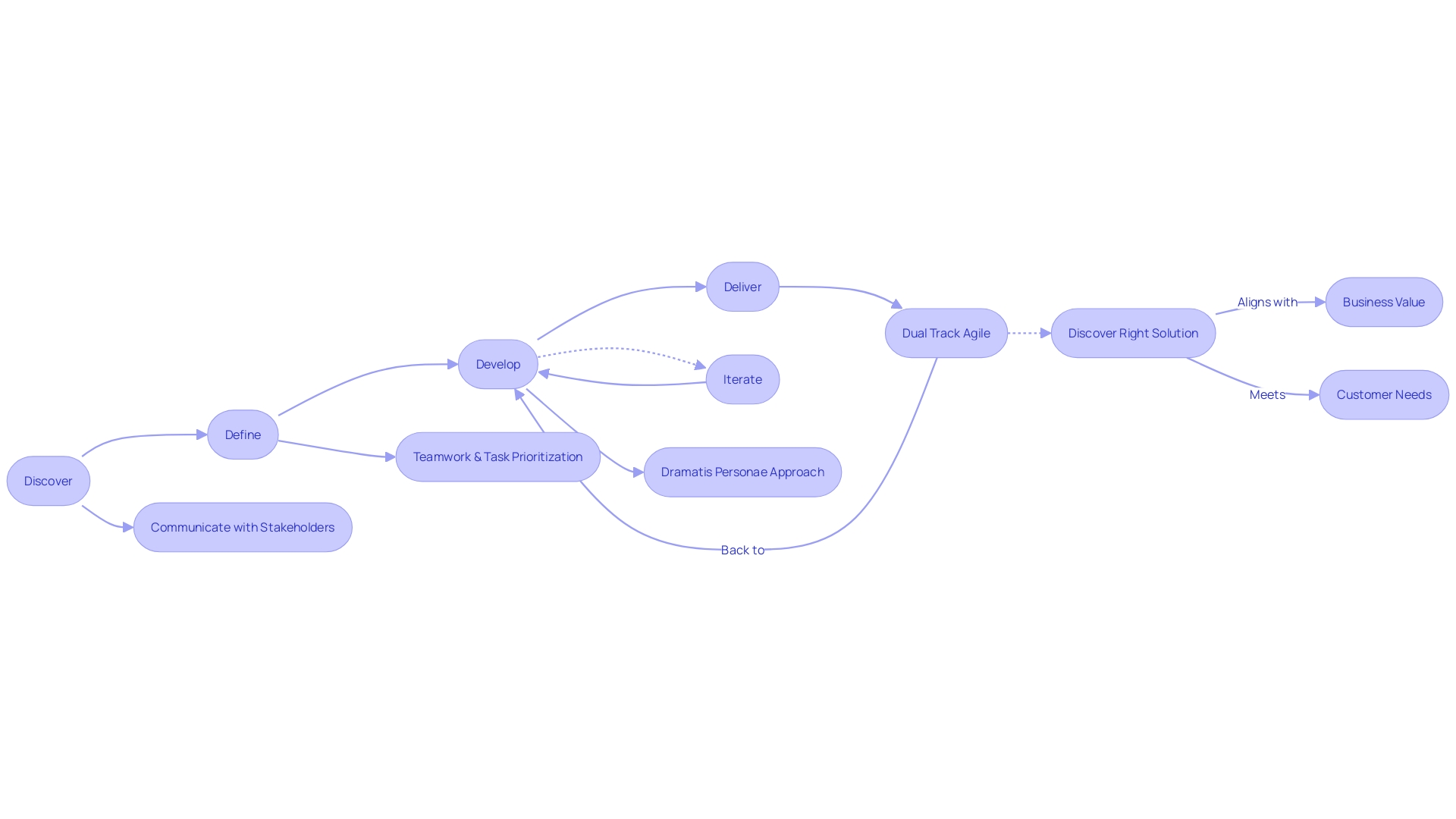
Best Practices for Implementing Agile Discovery
In the dynamic world of software development, embracing the Agile Discovery Process is crucial. Cross-functional collaboration is at its core, with teams from various disciplines bringing their expertise to the table, ensuring a well-rounded approach to project development. Regular retrospectives play a pivotal role, providing a structured opportunity to reflect on the process, celebrate successes, and identify areas for enhancement.
A commitment to a culture of experimentation and learning is the lifeblood of Agile, fostering an environment where trial and error lead to innovation and growth. This iterative approach, supported by real-time feedback from users and stakeholders, allows for continuous improvement and adaptability.
In the context of successful Agile implementation, a case in point is Credit Suisse's partnership with Kineo, which aimed to revolutionize eLearning within the bank, harnessing creativity and technology. Similarly, Bosch's development of the solid oxide fuel cell (SOFC) system, with its supporting digital twin, exemplifies Agile's strength in promoting flexibility and efficiency in energy solutions.
The Agile methodology, which has evolved since its inception in 2001, champions the principle of 'working software as the primary measure of progress,' as stated in the Agile Manifesto. This approach is in contrast to the traditional 'waterfall' method, which often lacks the agility to adapt to changes effectively.
Despite its proven success, Agile faces challenges in scaling within larger organizations. A comprehensive study found that while many companies undertake Agile transformations, only about half achieve the full benefits of increased productivity, faster time to market, and enhanced financial performance.
The takeaway for software development teams is clear: to leverage the full potential of Agile, one must not only adopt its practices but also cultivate the underlying principles that drive its success.
Conclusion
In conclusion, the Agile Discovery Process revolutionizes project management by emphasizing flexibility, collaboration, and iterative progress. It enables teams to pivot swiftly and deliver responsive outcomes based on customer feedback and market trends. By adopting Agile methodologies, organizations can significantly improve operations and achieve success.
Agile Discovery promotes a culture of continuous learning and innovation. Through user research, data analysis, and solution validation, teams develop targeted solutions that meet market needs. The iterative nature of Agile allows for ongoing refinement, ensuring high-quality products and exceptional user experiences.
To support the Agile Discovery Process, various tools and techniques are available. User personas, journey maps, and user stories help understand user needs and align solutions accordingly. Prototyping facilitates validation and adaptation, ensuring the delivery of effective solutions.
Implementing Agile Discovery comes with challenges, such as conflicting viewpoints and constrained resources. Effective communication, teamwork, and prioritization are crucial for overcoming these challenges. A culture of experimentation and learning is essential for driving innovation and growth.
To leverage the full potential of Agile, organizations must adopt its practices and cultivate the underlying principles. By embracing Agile principles and utilizing available tools, teams can navigate the complexities of software development and deliver products that exceed customer expectations.
In summary, the Agile Discovery Process transforms project management, enabling teams to adapt quickly and deliver responsive outcomes. By embracing Agile principles, organizations can foster a culture of innovation and continuous improvement. With the right tools and techniques, they can stay ahead in today's rapidly evolving digital landscape.





